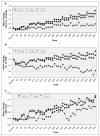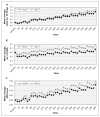Effect of polypharmacy, potentially inappropriate medications and anticholinergic burden on clinical outcomes: a retrospective cohort study - PubMed (original) (raw)
Effect of polypharmacy, potentially inappropriate medications and anticholinergic burden on clinical outcomes: a retrospective cohort study
Wan-Hsuan Lu et al. CMAJ. 2015.
Abstract
Background: Polypharmacy, potentially inappropriate medications and anticholinergic burden (as assessed by the anticholinergic risk scale) are commonly used as quality indicators of pharmacotherapy in older adults. However, their role in clinical practice is undefined. We sought to investigate longitudinal changes in these indicators and their effects on clinical outcomes.
Methods: We used Taiwan's Longitudinal Health Insurance Database to retrieve quarterly information about drug use for people aged 65 years and older over a 10-year period. We analyzed the association between indicators and all-cause admission to hospital, fracture-specific admission to hospital and death using generalized estimating equations.
Results: The study cohort comprised 59,042 older adults (65-74 yr: 39,358 [66.7%], 75-84 yr: 16,903 [28.6%], and ≥ 85 yr: 2781 [4.7%]). The mean changes in polypharmacy over the course of the study were greatest among patients aged 65-74 years (absolute difference +2.14, 95% confidence interval [CI] 2.10-2.19), then among those aged 75-84 yr (+1.79, 95% CI 1.70-1.88), and finally those aged 85 years and older (+0.71, 95% CI 0.36-1.05). The number of potentially inappropriate medications increased among patients aged 65-74 years (+0.16 [0.15-0.18]) and 75-84 years (+0.09 [0.06-0.08]), but decreased in those aged 85 years and older (-0.15 [-0.26 to -0.04]). Polypharmacy, potentially inappropriate medications and anticholinergic risk scale were each associated with an increased risk of admission to hospital, but not with death. In addition, both polypharmacy (5-9 drugs: odds ratio [OR] 1.18, 95% CI 1.12-1.24; ≥ 10 drugs: OR 1.54, 95% CI 1.42-1.66) and anticholinergic burden (score 1-2: 1.39, 95% CI 1.31-1.48; ≥ 3: 1.53, 95% CI 1.41-1.66) showed dose-response relations with fracture-specific admission to hospital.
Interpretation: The total number of drugs taken (polypharmacy), number of potentially inappropriate medications and anticholinergic risk changed during follow-up and varied across age groups in this cohort of older adult patients. These indicators showed dose-response relations with admission to hospital, but not with death.
© 2015 Canadian Medical Association or its licensors.
Figures
Figure 1:
Mean changes in polypharmacy (A), use of PIMs (B) and anticholinergic burden as determined by ARS score (C) over a 10-year quarterly follow-up, stratified by age. ARS = anticholinergic risk scale, PIM = potentially inappropriate medication.
Figure 2:
Mean changes in polypharmacy (A), use of PIMs (B) and anticholinergic burden as determined by ARS score (C) over a 10-year quarterly follow-up, stratified by sex. ARS = anticholinergic risk scale, PIM = potentially inappropriate medication.
Comment in
- Polypharmacy and clinical outcomes.
Shen HN. Shen HN. CMAJ. 2015 Aug 11;187(11):827. doi: 10.1503/cmaj.1150048. CMAJ. 2015. PMID: 26261270 Free PMC article. No abstract available. - Polypharmacy and clinical outcomes.
Lu WH, Wen YW, Chen LK, Hsiao FY. Lu WH, et al. CMAJ. 2015 Aug 11;187(11):827. doi: 10.1503/cmaj.1150049. CMAJ. 2015. PMID: 26261271 Free PMC article. No abstract available.
References
- Jyrkkä J, Enlund H, Korhonen MJ, et al. Patterns of drug use and factors associated with polypharmacy and excessive polypharmacy in elderly persons: results of the Kuopio 75+ study: a cross-sectional analysis. Drugs Aging 2009;26:493–503. - PubMed
- Fick DM, Cooper JW, Wade WE, et al. Updating the Beers criteria for potentially inappropriate medication use in older adults: results of a US consensus panel of experts. Arch Intern Med 2003;163:2716–24. - PubMed
- Rudd KM, Raehl CL, Bond CA, et al. Methods for assessing drug-related anticholinergic activity. Pharmacotherapy 2005;25:1592–601. - PubMed
- Fialová D, Topinkova E, Gambassi G, et al. Potentially inappropriate medication use among elderly home care patients in Europe. JAMA 2005;293:1348–58. - PubMed
Publication types
MeSH terms
Substances
LinkOut - more resources
Full Text Sources
Other Literature Sources

